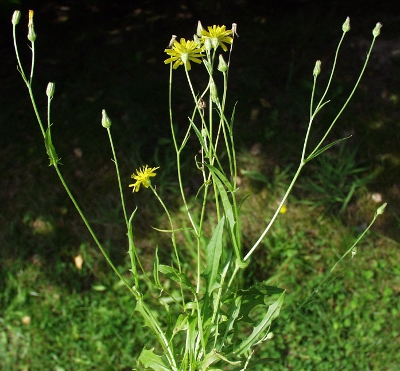Crepis, hawksbeard |

Smooth hawksbeard (Crepis capillaris)
Linnaeus used the name for a genus, in which he still listed at that time plants that are now assigned to the genera Hypochaeris and Hieracium and described it in 1754. The English name of the genus comes from the American botanist Asa Grey (8. 11. 1810 – 18. 1. 1888). He thus referred to the nasal bristles that surround the beak of a hawk - they should resemble the Pappus.
Krepis essentially means "sandal". It has already been referred to the shape of the basal leaves, the bracts and fruits. In addition, Krepis also means "foundations, basis", which could relate to the leaf rosette that lies often close to the ground.
Comprising 200 species, the genus originally occurs in North America, Europe, Asia and Africa and is now almost globally widespread. It consists of annual to perennial, herbaceous and lactiferous plants with taproots or rhizomes. The stems are upright to prostrate, often striped and often stiff-haired, bristly, simple or branched. The simple or pinnate leaves are sometimes toothed or serrated and arranged basal and cauline. The rosulate basal leaves are stalked, ovate to linear and lyrate, spatulate or runcinate. The alternate arranged stem leaves are often sessile and amplexicaul, simple or lobed. Often they decrease upwards in size.
The flower heads are yellow, orange or rarely pink, medium to large and consist exclusively of a few to more than 100 hermaphrodite florets with 5-dentate ligules, which shows underneath sometimes a red stripe. They are arranged in racemose, corymbose or paniculate inflorescences. Florets at the base without or with thin, narrow chaffy leaves. The 5–12 outer phyllaries are usually arranged in a single row. They are short and subulate and vary in size. The inner phyllaries are arranged in usually one or two rows and are much longer than the outer ones. They are lanceolate, glabrous, tomentose or bristly and have approximately the same size. Their margins are green or yellow and often membranous. Involucre cylindrical to bell-shaped. The usually pitted, sometimes bristly receptacle is flat or curved.
After self or insect pollination the inferior ovary forms a spindle-shaped or nearly cylindrical, sometimes beaked nut fruit (achene) with 10–20 ribs. At the significantly narrowed tip are white to yellowish, fragile and bristly sailing hairs (pappus), which are arranged in one to several circles, sometimes they are connected at the base.
| Floral formula: |
| ↓ K=pappus [C(5) A5(connate)] G(2) inferior |
Hawksbeards are closely related with the hawkweeds (Hieracium) and resemble them strongly. The genera can be distinguished by the outer ring of phyllaries, which consisting in Crepis of mostly reduced, short and often awl-shaped, sometimes protruding bracts while at Hieracium all phyllaries are similarly. In addition, the achenes at Crepis are significantly narrowed toward the tip.
Meaning of the species name
- capillaris: lat. capillaris = filiform, very slender